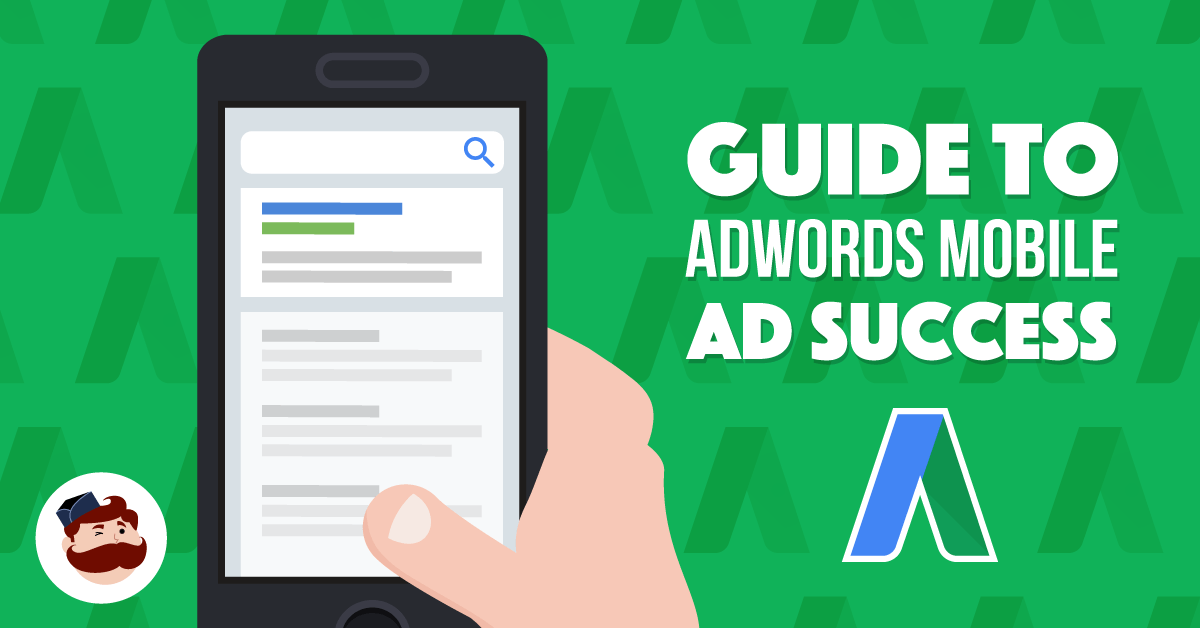
Share The Love:
Table of Contents

Google AdWords and Mobile-First Index: What You Need To Know For Mobile PPC Success
If you are staying up to date with all things Google and Google AdWords, you might have heard of the mobile-first index.
It’s easy to ignore if you are only interested in PPC success, but that’s a big mistake.
In fact, the mobile-first index will have a direct impact on advertisers using Google AdWords.

How? Why?
Well, that’s what you are here to find out.
Here’s everything you need to know about the mobile-first index, how it will impact your advertising efforts and what you can do to continually succeed.
What Is the Mobile-First Index?
Back in November 2016, we first got word from Google that they were testing a new way to index sites on their search engine by going mobile-first.
Naturally, this sent just about every marketer into a tailspin, wondering what massive changes were going to appear in the next few years. And rightfully so.
Up until then, desktop was the dominant force of traffic online. Mobile was growing, but for years and years, it was secondary to desktop optimization. Sure, you could run mobile campaigns back then, but they just weren’t as popular.
So, what exactly is the mobile-first index?
Essentially, in basic terms:
Google will now index your mobile site first, before indexing your desktop site when deciding what to rank on search results.
They are doing this for one simple reason:
Mobile traffic is more popular than desktop traffic now:
In the Google report, they said:
Today, most people are searching on Google using a mobile device. However, our ranking systems still typically look at the desktop version of a page’s content to evaluate its relevance to the user. This can cause issues when the mobile page has less content than the desktop page because our algorithms are not evaluating the actual page that is seen by a mobile searcher.”
Basically, users were getting bad experiences on mobile because their algorithms were analyzing desktop sites that might not have been optimized for mobile browsing.
So despite the content being good, the mobile experience could have been awful depending on what you searched for and what sites you clicked.
Just recently in 2018, Google announced that the mobile-first index had begun its rollout to major websites (and ones prepared for it).

One key takeaway from Google’s reports is that mobile-friendly and mobile responsive sites are critical to success with the mobile-first index.
So, I know what you might be thinking:
How does this have anything to do with AdWords and PPC marketing?
Here’s how.
Why and How Will Mobile-First Indexing Impact PPC Advertising?
This update to Google’s core algorithm should serve as a wake-up call to the pay per click community.
Most people are searching for information, products, and services on mobile devices now. Yet most of us are still running ads with desktop priority to desktop focused sites, putting mobile on the backburner.
If most traffic is coming from mobile searches, yet you focus optimization on desktop, you are dinging yourself both organically and in paid search.
This update is a blessing in disguise, helping us advertisers to realize that mobile is the future and that we needed optimized sites yesterday.
Think of it this way:
A user conducts their search on Google. They want to find a new product. So they click on the first ad result, which is your ad.
Your ad is fantastic and drives the click.
But since desktop is your primary site and mobile is just an afterthought, they are met with confusing navigation, slow load times due to bloated page sizes, and page elements that don’t scale properly on mobile.
Why? Because you aren’t treating mobile as its own entity, despite mobile browsing being completely different than desktop browsing.
For instance, you have less room to work with, meaning navigation and page elements have to change. People using mobile don’t want to fill out lengthy forms, so those won’t work either.
The fact of the matter is, mobile is vastly different and simply thinking that your desktop site can convert mobile users is dangerous for your bottom line.
Here are a few ways that you can prepare for the mobile-first index and improve mobile advertising on AdWords.
Put Effort Into a Mobile-Specific Design
To comply with the mobile-first index and prepare your site for increasing mobile traffic, you should first start by implementing a mobile-friendly or responsive design.
Meaning your content on your desktop site should automatically update and reflect on mobile, as well as page and navigation elements that shrink and fit appropriately on smaller devices.
Depending on what site management system you use, like WordPress, you can use plugins to create optimized and friendly mobile sites:
This is without a doubt the easiest way to convert your desktop site into a mobile-friendly site.
While it’s a significant and necessary step in the right direction, you shouldn’t seek to emulate your desktop site for mobile. Screen sizes and speed are so different that doing so could hurt your sales potential with PPC ads.
Since you pay for every single click, it’s vitally important that you give mobile the royal treatment:
Invest in mobile-specific design. A design that is built from the ground up specifically with mobile users in mind, rather than a desktop site shrunk to fit an iPhone screen.
HubSpot tested this with their lead magnets recently. Using a mobile-friendly design, their desktop content updated dynamically to mobile:

But that only led to long, bloated pages that took up way too much screen real estate and time to read for a small device.
Instead of sticking with mobile-friendly design, they started tackling the layout on mobile as a separate entity, shrinking and simplifying everything to make the UX better:

They reduced form sizes to a single page. They shrunk menus to have flat site architecture, a winning element of mobile-centric design.
The results? A 27% decrease in bounce rates and skyrocketing conversions.
It’s easy as pie to flip a switch and have a mobile-friendly site that reflects your desktop site in an easier to use fashion.
But in this case, easier isn’t better when your bottom line is at play with every single click. Giving sub-par experiences is a surefire way to waste money on AdWords.
With growing mobile traffic and importance placed on mobile optimization, focused and mobile-specific design is key.
Focus on Improving Your Site Speed
When it comes to success on AdWords, a huge factor is your landing page. Not only is it a primary component of your quality score, but it also determines whether or not people convert. Whether or not that click you just paid for comes right out of your bank account with no return.
Getting people to click is just the first step. It’s easy in comparison to getting someone to actually convert on what you have to offer. Got a bad landing page? You can expect higher costs per click and worse conversions.
That means your acquisition costs will be sky high for every user you acquire. And on mobile, landing pages become even more difficult.
Every single second “extra” that your page takes to load can result in exponentially increasing bounce rates:
That means clicks could be paid and bought, yet you’d have nothing to show for it. People don’t want to wait, especially on mobile devices.
But…
Since most brands just optimize their mobile site based on desktop, their sites are extremely slow:
According to Google, average speeds for mobile sites across every single industry are at least 2.5x slower than the best practice. And as you saw above, even a few seconds above three can result in 100%+ increases in bounce rate.
Speed is the name of the game on mobile sites, but it’s often not possible when you simply provide a mobile-friendly version.
Instead, continue your efforts on mobile-first design.
Lighten up pages by compressing images.
Remove large elements like sliders or extended forms.
Condense pages and eliminate text that isn’t crucial.
Doing all of this will result in increased speed and less wasted money. Plus, it will also help your organic results at the same time.
Now, Hammer Home Mobile Ads on AdWords.
Google AdWords has multiple amazing options for advertising strictly on mobile.
For instance, you can run call-only ads on mobile that feature a click to call option.
These are great for driving fast calls to your business.

You can even run mobile-based Gmail ad campaigns with beautiful layouts that utilize images and links rather than large landing pages with tons of text (that most people on mobile skim anyway).
This is a great option to build brand awareness and bring users back to your optimized mobile site where they can continue the great experience they found with your Gmail ad.
The options are almost endless on what you can do with mobile ads.
When creating your next campaign, be sure to adjust your targeting settings and create mobile-only campaigns.
In your dashboard, you can navigate to the campaign settings section on a given campaign:

From here, expand your “Additional settings” and locate the “Devices” tab:

Now you can customize the specific devices that you want to target by selecting “Set specific targeting for devices.”

Check off the devices that you want to target. In this case, mobile (or both mobile and tablet) is what you want to choose.
If you want to get even more specific, you can sort by operating systems or device models depending on what types of campaigns you are looking to run.
This is an excellent option for display campaigns, but what about the search network?
If you are running a search network campaign, things get a bit more complicated.
That lovely device selection setting isn’t available for you. And simply navigating to the devices tab on your dashboard gives you no options either.

So, what do you do?
You set some new bid adjustments! Since there isn’t currently an option to remove computers and tablets from your targeting, bidding is your best bet.
If you want this to be a truly mobile-only campaign, select both computers and tablets.
Decrease their bids by 100%:

For instance, if you were bidding $10 on each of these, they’d be set to zero, making mobile the only focus of your bidding and clicks.
While not perfect, it’s an easy way to eliminate non-mobile traffic from your campaign to specialize it.
If you want, you can always create a second identical campaign targeted for just desktop traffic, too.
This will allow you to capitalize on both desktop and mobile visits while providing mobile with their own specifically tailored experience.
Win-win!

(Gif Source)
Next, you can start to setup ad extensions tailored toward mobile devices.
For example, phone call extensions that display your business number next to your website, giving users the option to call or click to your landing page.
One of my favorite extensions for mobile device targeting is sitelinks:

Sitelink extensions are a great way to provide more relevant links based on your ad text.
This works well on mobile because it allows users to instantly navigate to the page they find the most interesting, rather than forcing them to use poor menu navigation on your mobile website itself.
Meaning they have a lower likelihood of getting frustrated with your UX and bouncing.
Include 2-3 relevant sitelinks for each ad and be sure to relate them to the products you are advertising.
Now, just sit back, relax and adjust your campaigns as results come in.
Conclusion
With the news breaking of the Google mobile-first index rolling out, now is the time to invest in your mobile optimization.
If anything, let it serve as a wake-up call that mobile traffic is increasing and the demands of consumers are shifting to better mobile sites.
If your mobile site is slow and has a bad interface, you can expect both bad organic results and wasted money on clicks that don’t convert.
The mobile-first index shows that users and Google care about the website experience, not just content.
Even if your offer is gold, a bad experience could set you back big time.
- Start by making sure your mobile site is responsive.
- Put more effort into a mobile-specific design that works well on mobile and isn’t just optimized from your desktop page.
- Improve your site speed by reducing large image files and removing big page elements that don’t add enough value.
- Lastly, start running more mobile targeted ads on AdWords.
Focus your campaigns on mobile users and reap the rewards of growing mobile traffic with a perfectly optimized mobile site.
https://adespresso.com/blog/adwords-mobile-first-index/
On – 09 Jul, 2018 By Brad Smith
Tags
Share This



